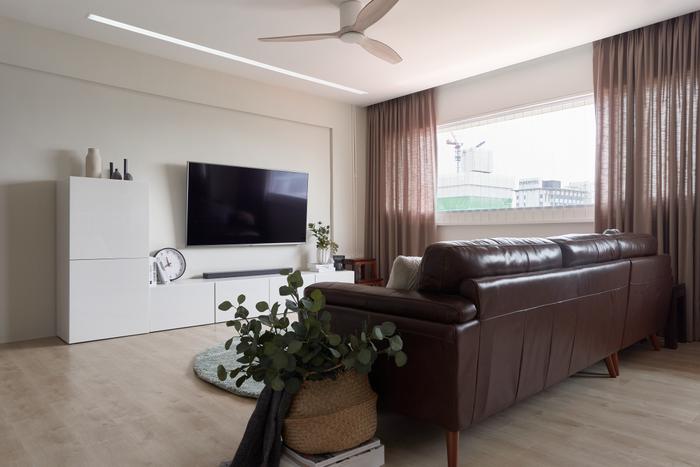Serious effort was made to transform this Rowell Road HDB flat into a tranquil abode.
Moving into an old (read: 20 years or more) HDB flat is often a challenging process because of the sheer amount of renovation work that goes into updating it. New furniture needs to be bought, the layout has to be re-worked for efficiency, and more often than not, just about everything has to be stripped out for a complete makeover.

View this project by Happe Design Atelier
Such a daunting task awaited the current occupants of this Rowell Road HDB flat – which was originally built in 1982 – when they received it from its previous owners. Fortunately, they had a helping hand from Happe Design Atelier’s Choo Yih and Daniel, who did more than just restore their home into tip-top shape – here’s what both designers accomplished!
About the design brief
Choo Yih (CY): The owners of this home are a young couple, and because they were expecting a new child, the renovation had to be completed within two months. Although we managed to complete the project on time, there was a bit of uncertainty because the entire block was undergoing HDB upgrading back then.

The home’s new floor plan.
Basically, they were looking for a Scandinavian-style home – something that looks clean and simple with a communal space for social gatherings.
Also, because this was a family home that was passed down, there were existing features, like vintage wall tiles, that the owners wanted to keep intact for sentimentality. But ultimately, they had to forgo this decision, both for practical and aesthetic reasons.

The home’s hacking plan. Red outlines indicate where walls were torn down during the renovation.
Daniel (D): Furthermore, because the owners wanted very clean and bright spaces, we had to knock down some walls, like the ones around the bedrooms, storeroom, and kitchen. By doing so, we were able to optimise the flat’s layout, let more daylight in, and also create several open-concept areas where possible.
About the living room
CY: For future-proofing reasons, built-ins were minimised in general for the living area so the owners can retro-fit the space if they want to and also provide their child with enough room to play around freely; the only fixture is a storage settee at the back.
The walls of the bedroom closest to the living area were also hacked off and it was combined with the original living room to create an extra-large communal zone.

D: Overall, the colour scheme of the living room and the rest of the house is off-white combined with light, creamy neutrals, but since the owners wanted some dark accents, there are also wood tones that are darker and more reddish – which can be found in the furniture and doors.
For the flooring, a lighter tone was chosen, so it would contrast with the furniture for a less-monotonous look; wood-look vinyl was used for child safety reasons, and also because there’s actually a retro terrazzo floor below that was intentionally kept intact.
About the dry and wet kitchen

D: The dry and wet kitchens that you see now were one large space originally, but the entire area was quite cramped because it was really long and closed-off – the distance from the kitchen entrance to the service area is about 8 meters, which is definitely more than a BTO flat’s – so turning it into an open-concept space definitely benefitted the owners.

The kitchen before (right) and after (left) the renovation.
We also built a partition to cover up a full-height gas pipe, extended the wet zone into the yard, and split the common bathroom/service area at the back into two spaces – one for the toilet and one for the washing machine.
Additionally, there was a 10 cm drop where the dry kitchen is now, so we had to raise the kitchen’s floor for it to be level with the living room. As for the breakfast counter, it’s built not just for having meals, but also to create a flushed entrance with an adjoining structural pillar that couldn’t be removed.

Sleek custom cabinets were built to function as storage nooks and additional counter space.
CY: I’d say the rest of the kitchen’s makeover was pretty simple, basically it involved putting in the necessary fixtures and fittings.
However, to achieve the clean, minimalist look, we did something special for the side cabinets; these built-ins were made to be a little deeper than usual, so they can serve as an additional workspace when the cabinet doors are opened up. But when they are closed there’s no visible clutter.
About the master bedroom and en suite

D: The owners wanted a minimalist look for their bedroom, so most of the details were kept simple – the colour palette is mostly grey and warm browns with herringbone patterns for the wardrobe and vanity area’s flooring to accompany them as subtle accents.
Having said that, renovating the entire master bedroom was quite complicated, mainly because we had to re-work the layout – both on the inside and outside – to accomplish what the owners asked for.

Basically, if you take a look at the hacking plans, you’ll see that we had to expand the master bedroom and en suite to accommodate the new vanity area and a bathtub; we did this by re-orientating the existing master bedroom entrance as well as shrinking one of the junior bedrooms to create more space.

In addition to its new bathtub, the master en suite also had a fresh layer of 60 x 120cm tiles installed for easier maintenance and an overall cleaner visual profile.
Although we succeeded in fitting the bathtub as well as a separate shower area into the en suite, the whole process was quite challenging as the entire space was still quite tight even after the master bedroom was expanded – in fact, the bathtub was the smallest one that we could find in the shop!
To sum up

D: I’d say that both myself and Choo Yih, as well as the rest of the Happe team, agree that this was a challenging project because we had to pay close attention to all the little details and the unique layout to accomplish what we’ve done. We’re definitely happy with the final result and so are the homeowners as the flat’s look and feel turned out to be exactly what they wanted.
Now's a good time as any to get started on your renovation plans!
Many Singapore homeowners have had to put their renovations on hold due to COVID-19, BUT that doesn't mean you can't start planning for yours now.
Ironing out the kinks in your home makeover plan will enable it to proceed smoothly once circumstances improve, so if you’d like some professional help let us know and we'll link you up with local interior firms that offer virtual consultations!

 Get a budget estimate before meeting IDs
Get a budget estimate before meeting IDs